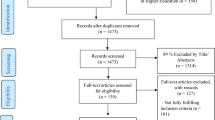Abstract
We survey tenure-track faculty members employed in three fields in colleges of agriculture at land-grant universities—agricultural economics, agronomy, and food science—to evaluate the effects of different employment structures and incentives on research productivity. These evaluations include conducting statistical tests to assess any effects of different academic appointments and developing a regression model to measure the effects of these and other attributes on individual research productivity, as defined by the number of publications in the Thomson ISI Web of Science. We find faculty who hold larger teaching and extension appointments produce fewer publications; we also find positive effects on the number of publications for grants and university funding, multi-institutional research collaboration, and number of graduate students advised.
Similar content being viewed by others
Notes
For a more detailed description of the nature of faculty appointments in colleges of agriculture at land-grant universities, please visit http://caes.ucdavis.edu/facstaff/ce/ce-mentor-handbook.pdf.
The authors do not provide any details regarding these articles; thus, these articles may or may not refer to publications in the WoS.
A small number of individuals effectively removed themselves from our database because they informed us that they no longer met our selection criteria.
The minimum teaching appointment is 4 percent, which we surmise may result from a number of universities that require teaching appointments in order for faculty to be eligible to receive tenure.
We chose a teaching appointment of 25 % because it is typical of teaching faculty in colleges of agriculture; in fact, in our sample the average teaching appointment was 24.6 % and the most common appointment was 30 %.
We acknowledge this quantitative finding does not account for any changes in the quality of either teaching or research outputs that may occur with changes in appointments.
References
Abramo, G., & D’Angelo, C. A. (2009). Assessing technical and cost efficiency of research activities: A case study of the Italian university system. Research Evaluation, 18(1), 61–70.
Amara, N., & Landry, R. (2012). Counting citations in the field of business and management: Why use Google Scholar rather than the Web of Science. Scientometrics,. doi:10.1007/s11192-012-0729-2.
Barro, R. J. (2001). Human capital and growth. The American Economic Review, 91(2), 12–17.
Becker, G. S. (1962). Investment in human capital: A theoretical analysis. Journal of Political Economy, 70(5), 9–49.
Blumenthal, D., Campbell, E. G., Causino, N., & Louis, K. S. (1996). Participation of life-science faculty in research relationships with industry. The New England Journal of Medicine, 335(23), 1734–1739.
Fairweather, J. S. (1999). The highly productive faculty member: Confronting the mythologies of faculty work. In W. G. Tierney (Ed.), Faculty productivity: Facts, fictions, and issues (pp. 55–98). New York: Falmer Press.
Fairweather, J. S. (2002). The mythologies of faculty productivity: Implications for institutional policy and decision making. The Journal of Higher Education, 73(1), 26–48.
Fenker, R. M. (1977). The incentive structure of a university. The Journal of Higher Education, 48(4), 453–471.
Foltz, J. D., & Barham, B. L. (2009). The productivity effects of extension appointments in land-grant colleges. Review of Agricultural Economics, 31(4), 712–733.
Gibbons, M., Limoges, C., Nowotny, H., Schwartzman, S., Scott, P., & Trow, M. (1994). The new production of knowledge: The dynamics of science and research in contemporary societies. London: Sage.
Gorraiz, J., Greil, M., Mayer, W., Reimann, R., & Schiebel, E. (2009). International publication output and research impact in social sciences: Comparison of the Universities of Vienna, Zurich, and Oslo. Research Evaluation, 18(3), 221–232.
Hilmer, C. E., & Hilmer, M. J. (2005). How do journal quality, co-authorship, and author order affect agricultural economists’ salaries? American Journal of Agricultural Economics, 87(2), 509–523.
Konrad, A. M., & Pfeffer, J. (1990). Do you get what you deserve? Factors affecting the relationship between productivity and pay. Administrative Science Quarterly, 35, 258–285.
Lee, S., & Bozeman, B. (2005). The impact of research collaboration on scientific productivity. Social Studies of Science, 35(5), 673–702.
Long, R., Crawford, A., White, M., & Davis, K. (2009). Determinants of faculty research productivity in information systems: An empirical analysis of the impact of academic origin and academic affiliation. Scientometrics, 78(2), 231–260.
O’Meara, K. A. (2006). Encouraging multiple forms of scholarship in faculty reward systems: Influence of faculty work life. Planning for Higher Education, 34(2), 43–53.
Ponomariov, B. L., & Boardman, P. C. (2010). Influencing scientists’ collaboration and productivity patterns through new institutions: University research centers and scientific and technical human capital. Research Policy, 39, 613–624.
Porter, S. R., & Toutkoushian, R. K. (2006). Institutional research productivity and the connection to average student quality and overall reputation. Economics of Education Review, 25, 605–617.
Shin, J. C., & Cummings, W. K. (2010). Multilevel analysis of academic publishing across disciplines: Research preference, collaboration, and time on research. Scientometrics, 85(2), 581–594.
Smart, J. C. (1978). Diversity of academic organizations: Faculty incentives. The Journal of Higher Education, 49(5), 403–419.
Toutkoushian, R. K., Porter, S. R., Danielson, C., & Hollis, P. R. (2003). Using publication counts to measure an institution’s research productivity. Research in Higher Education, 44(2), 121–148.
Author information
Authors and Affiliations
Corresponding author
Electronic supplementary material
Below is the link to the electronic supplementary material.
Rights and permissions
About this article
Cite this article
Miller, J.C., Coble, K.H. & Lusk, J.L. Evaluating top faculty researchers and the incentives that motivate them. Scientometrics 97, 519–533 (2013). https://doi.org/10.1007/s11192-013-0987-7
Received:
Published:
Issue Date:
DOI: https://doi.org/10.1007/s11192-013-0987-7




